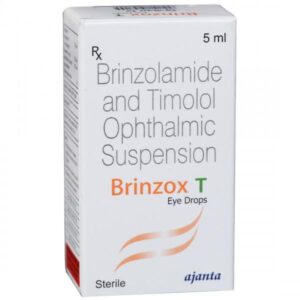TIMOLOL + BRINZOLAMIDE
Timolol: Timolol is a nonselective beta-adrenergic receptor antagonist, commonly known as a beta-blocker, that is used to treat various conditions including high blood pressure, heart disease, and glaucoma. It is available in various forms including eye drops, tablets, and injections.
In glaucoma treatment, Timolol is primarily used as an eye drop to lower intraocular pressure (IOP) and reduce the risk of vision loss. It works by reducing the production of fluid (aqueous humor) in the eye, thereby lowering the IOP.
The recommended dose of Timolol eye drops is typically one drop in the affected eye(s) twice a day. However, it is important to follow the dosage instructions provided by the doctor as they may vary based on the individual’s condition.
Common side effects of Timolol eye drops include mild eye irritation, stinging or burning sensation, blurred vision, dry eyes, and a change in taste sensation. These side effects are usually mild and temporary. If these symptoms persist or worsen, it is advisable to consult a healthcare professional.
In addition, Timolol may also have systemic side effects when taken orally or injected. These can include fatigue, dizziness, low blood pressure, slowed heart rate, breathing difficulties, depression, and cold hands and feet. It is important to inform the doctor about any pre-existing medical conditions or medications being taken before starting Timolol.
As with any medication, it is crucial to use Timolol as directed and to follow up with regular eye exams to monitor the effectiveness of the treatment.
Brinzolamide: Brinzolamide is a medication that belongs to the class of drugs known as carbonic anhydrase inhibitors. It is primarily used in the treatment of open-angle glaucoma and ocular hypertension, conditions that can cause increased pressure in the eye. By reducing intraocular pressure, Brinzolamide helps to prevent damage to the optic nerve, thus preserving vision.
The drug works by inhibiting the activity of the enzyme carbonic anhydrase, which plays a role in the production of fluid within the eye. By inhibiting this enzyme, Brinzolamide reduces the production of aqueous humor, the fluid that fills the front part of the eye. This helps to lower the pressure within the eye and prevent further damage to the optic nerve.
Brinzolamide is typically administered as eye drops. The usual recommended dose is one drop in the affected eye(s) three times a day. It is important to follow the instructions provided by your healthcare provider regarding the exact dosing schedule.
Like any medication, Brinzolamide may cause side effects in some individuals. Common side effects may include a bitter or unusual taste in the mouth, blurred vision, eye discomfort or irritation, dry eyes, and headache. These side effects are generally mild and temporary. However, if you experience any severe or persistent side effects, it is important to seek medical attention.
In rare cases, Brinzolamide may cause more serious side effects such as allergic reactions, swelling of the eyelids or face, eye pain, sensitivity to light, or worsening of vision. If you experience any of these symptoms, you should stop using the medication and contact your healthcare provider immediately.
It is worth noting that Brinzolamide may interact with other medications, such as other carbonic anhydrase inhibitors, leading to potential drug interactions. Therefore, it is important to inform your healthcare provider about all the medications you are taking before starting Brinzolamide.
Overall, Brinzolamide is an effective medication for reducing intraocular pressure in the treatment of open-angle glaucoma and ocular hypertension. However, it is essential to follow your healthcare provider’s instructions and report any concerning side effects for proper management.

